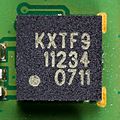Accelerometer facts for kids
An accelerometer is a clever device that measures how much an object is speeding up, slowing down, or changing direction. It also senses the force of gravity. Think of it as a sensor that "feels" movement and tilt. This measurement is called "proper acceleration," which is the acceleration you actually feel, like when you're pushed back into your seat as a car speeds up.
Accelerometers are built using special materials that change their electrical properties when they move or are squeezed. These can be piezoelectric, piezoresistive, or capacitive components. They are super useful in many gadgets and machines we use every day.
Contents
Accelerometers: What They Are
An accelerometer is a type of sensor that measures acceleration. Acceleration is how quickly something changes its speed or direction. If you are standing still, you feel the pull of gravity. An accelerometer can measure this pull. If you are in a car that suddenly brakes, you feel a push forward. An accelerometer can measure that too.
These devices work by sensing tiny changes in their internal parts. When the accelerometer moves, a small mass inside it also moves. This movement creates an electrical signal that tells us how much acceleration is happening.
How Accelerometers Work
Most accelerometers use a tiny weight or mass that is connected to a spring-like structure. When the device accelerates, this weight moves due to inertia. The movement of the weight causes a change in an electrical signal.
- Piezoelectric accelerometers use materials that create an electric charge when they are squeezed or bent.
- Piezoresistive accelerometers use materials whose electrical resistance changes when they are stretched or compressed.
- Capacitive accelerometers measure changes in electrical capacitance as parts of the sensor move closer or farther apart.
These tiny electrical changes are then converted into a measurement of acceleration.
Where Are Accelerometers Used?
Accelerometers are found in many different places, from your pocket to outer space! They help make many technologies work smoothly and safely.
In Phones and Tablets
Have you ever noticed how your phone screen automatically rotates when you turn it sideways? That's an accelerometer at work! It detects the tilt of your device and tells the screen to adjust. Accelerometers also help with gaming, allowing you to steer or control characters by tilting your phone. They can even count your steps as a pedometer.
For Drones and Aircraft
Accelerometers are very important for keeping drones stable in the air. They help the drone know its orientation and how it's moving, allowing it to balance itself. In larger aircraft and missiles, accelerometers are part of "inertial navigation systems." These systems help planes and rockets know their exact position, speed, and direction without needing outside signals like GPS.
Measuring Gravity
Specialized accelerometers can measure tiny differences in gravity. This is called "gravity gradiometry." Gravity is a weak force, and its strength can change slightly depending on the density of the ground below. By measuring these small changes, scientists can learn about what's underground, like finding oil or water, or even studying Earth's structure.
Detecting Vibrations
In large machines, like engines or industrial equipment, accelerometers are used to detect vibrations. If a machine starts vibrating too much, it might mean something is wrong or about to break. By monitoring these vibrations, engineers can fix problems early, preventing costly damage and keeping machines running safely.
Images for kids
See also
 In Spanish: Acelerómetro para niños
In Spanish: Acelerómetro para niños


